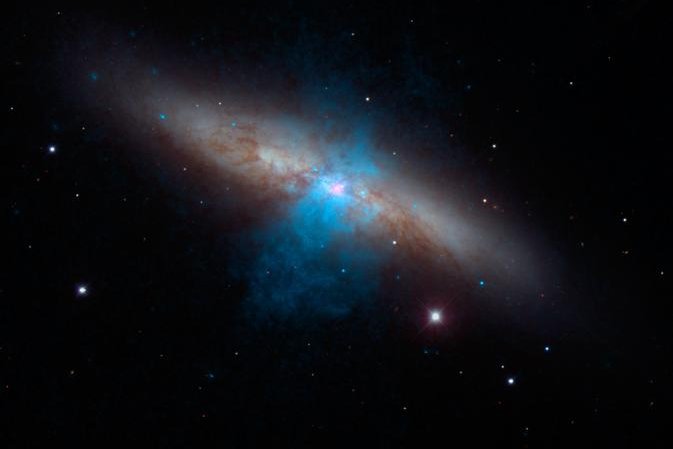The strange and oddly powerful pulsar (the pink dot) is seen in the Messier 82 galaxy in this enhanced multi-wavelength portrait. (NASA/JPL-Caltech)
PASADENA, Calif., Oct. 9 (UPI) -- Scientists say they've detected the brightest pulsar ever -- a discovery as remarkable as it is confounding. Despite its small dimensions and modest mass, the pulsating dead star is burning with the energy of 10 million suns.
The pulsar is now one of space's strange ultraluminous X-ray (ULX) sources -- a classification offered to cosmic objects that give off more energy than scientists' current understanding of stellar radiation processes can explain.
The discovery was made by a team of astronomers and astrophysicists from NASA, MIT and Caltech with the help of the U.S. space agency's Nuclear Spectroscopic Telescope Array, or NuSTAR. The recently located pulsar is in the galaxy Messier 82, only 12 million light-years away.
The pulsar doesn't radiate as a result of stellar fusion -- it's dead, remember? Instead, it emits X-rays as a result of the cosmic matter its gravity pulls in and consumes.
"The pulsar appears to be eating the equivalent of a black hole diet," Fiona Harrison, the NuSTAR principal investigator at Caltech, said in a press release. "This result will help us understand how black holes gorge and grow so quickly, which is an important event in the formation of galaxies and structures in the universe."
Scientists know the pulsar is a pulsar and not a black hole because black holes don't give off a pulse. Previously, astronomers have found a pulsar's brightness is relative to its mass -- mass determines to the pulling power of the dead star's gravity, and thus should limit the amount of cosmic matter it can eat and the radiation it can give off. But this particular pulsar gives off about 100 times more radiation than one would expect, given all scientists know about the small stars.
"One of the big puzzles here is how to reconcile this," Deepto Chakrabarty, head of the astrophysics department at MIT, said in a press release. "And we don't yet have an answer to that."
"ULXs are already oddballs," Chakrabarty added. "It might be that this [pulsar] is an oddball among the oddballs -- it's a pulsar, but it's this weird outlier, and everything else is a black hole. Or it might be that some substantial fraction of ULX sources is pulsars. But there are already various indications that these ULX sources do seem to be quite unusual compared to most things we know in our galaxy."
For now, the only certainty is that this star is both the biggest and strangest pulsar astronomers have ever found.















